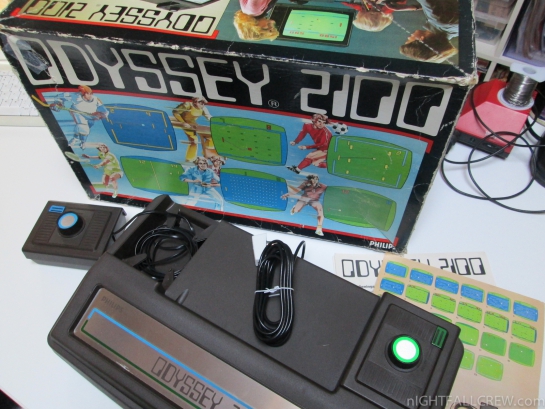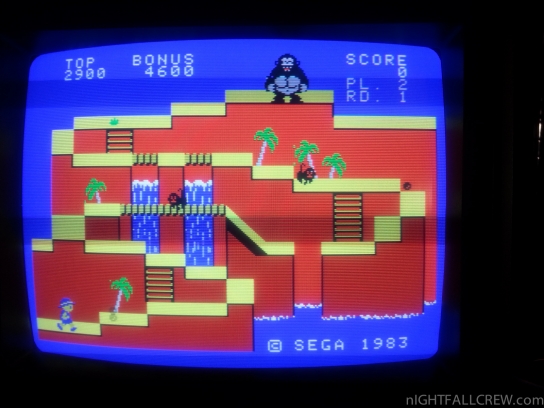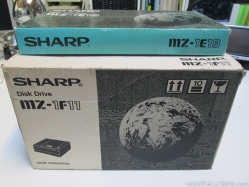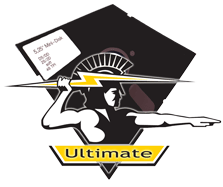Celebrazione Commodore 64 a Pozzecco (UD)
Sorry, this entry is only available in Italian.
Sorry, this entry is only available in Italian.
I was very lucky in this repair, the fault is a broken belt that is used for the operation of the Floppy “Quick Disk”.
?hd=1
I post some screenshots and a video of the repairing of a NEC PC-Engine LT console.
Defect in the console:
Some capacitors have leaked acid on the pcb, i had to clean with the right product made especially for cleaning the pcb before proceeding with the replacement operation. The LCD screen is was disassembled to remove the dirt inside.
![C64 Game: Star Trek (2003) +5H [pal/ntsc] / Telengard V5.1](https://www.nightfallcrew.com/wp-content/uploads/2012/11/c64_16_11_2k12-300x225.png?76c919) Some new games (Cracked / Trained or Unrealeased) for Commodore 64 have been released from your favorites groups: Antarctica, WST, Mayday!, Really Proud Lamers, TRIAD and Laxity.
Some new games (Cracked / Trained or Unrealeased) for Commodore 64 have been released from your favorites groups: Antarctica, WST, Mayday!, Really Proud Lamers, TRIAD and Laxity.
Download:
source: csdb.dk
 The HxC Floppy Drive Emulator is a software and hardware system created by jfdn aka Jeff.
The HxC Floppy Drive Emulator is a software and hardware system created by jfdn aka Jeff.
The aim of this project is to replace the floppy disk drive by an electronic device emulating the floppy disk drive (list of supported Computer/Hardware).
There are two differents emulators:
Firmware SD HxCFloppyEmulator v1.7.2.0:
Release notes for the HxCFloppyEmulator software v2.0.6.0:
Download:
source: hxc2001.free.fr

Autopsy:
from Wikipedia homepage:
The Odyssey 2100 was released in 1978 and uses the same case design as the 2001. Using the National Semiconductor MM-57186N chip, the 2100 plays 6 games with multiple varitions: Wipe-Out (Breakout style, 7 variants), Flipper (7 variants), Tennis (2 variants), Handball (2 variants), Ice Hockey (2 variants), Football (3 variants).
The Magnavox Odyssey was a general brand name of the company’s complete line of home video game consoles released from 1972 through 1978. The line includes the original Magnavox Odyssey console, both Magnavox and Philips versions of the Odyssey series of dedicated video game consoles, and the Magnavox Odyssey² cartridge-based video game console released in 1978.
source: wikipedia

Autopsy:
from MyOldComputers.com:
The year was 1978. Atari was at the top of the video gamming world with its 2600 VCS game console. Atari management looked around and saw a new and potentially lucrative market just beginning to take shape. This market was the Home Computer Market. They saw a market with relatively few major competitors and Atari was in a great position to market a computer of their own. They, after all, were a trusted household name, everyone owned an Atari or knew someone who did!
So December of 1978 Atari introduced the 400 and 800 series computers. The actual computers were not delivered until late 1979 due to production problems. The 400 was a scaled down version of the Atari 800. Introduced as an entry level computer based on the same MOSTEK 6502A processor running at 1.70 MHz with 16K of user RAM built in. It had a membrane style keyboard (not very touch type friendly) with 62 touch sensitive keys and 4 special keys to the right of the keyboard.
It stood out amongst the other computer offerings of the day with its graphics and sound capabilities. It was capable of producing 128 colors on the screen using the CTIA video processor and up to 256 colors with the upgraded GTIA video processor chip used on later versions of the computer. The 400 was first amongst the early computers to be able to display 4 programmable screen objects simultaneously called ‘Player-missiles’ (also known as ‘Sprites’ on Commodore computers). This was at a time when the most computers produced only monochrome displays or very primitive 8 color screens. The graphics were handled by a custom chip called the “ANTIC” (CTIA/GTIA). This chip was designed to work as a sort of co-processor to take the work load away from the main processor to display graphics and color on the screen.
The team that developed the custom chips inside the 400 and 800 was headed by Jay Miner who later, after leaving Atari, headed the teams who developed the custom chips that surrounded the Motorola MC68000 processor that powered arguably the most advanced computer of its time, The Amiga 1000!
source: myoldcomputers.com

Autopsy:
This is a gift from my brother for my birthday.
from Wikipedia:
Congo Bongo (J: Tip Top (ティップタップ Tippu Tappu?)) is an isometric platform arcade game released by Sega in 1983. Strong evidence from analysis of the game’s ROM claim that Ikegami Tsushinki also did development work on Congo Bongo.
The game has come to be seen as Sega’s answer to the highly successful Donkey Kong game that was released two years prior. The player takes the role of a red-nosed safari hunter who tries to catch an ape named “Bongo”. The hunter seeks Bongo to exact revenge for an apparent practical joke in which Bongo set fire to the hunter’s tent, giving him a literal “hotfoot”. Game was named by Pete Gorrie who was the CFO at that time.
source: wikipedia

Autopsy:
Thanks go to Andrea Pierdomenico for sending these two things in perfect condition and ‘seems’ never used.
from SharpMz.org:
The Quick Disk drive in terms of cost is was a more practical proposition for the home user. The drive is built into the computer for the MZ-700 and MZ-800 in place of the data recorder.
The Quick Disk allows you to load 64K of sequential data in 8 seconds, which is a vast improvement in performance compared to cassette tapes. However, the Quick Disk operates in a very similar way to cassette tapes in that data has to be accessed sequentially, rather than at random as is possible with the floppy drives.
A special Quick BASIC is supplied. However, perhaps the most interesting way of using the Quick Disk would be as a back-up store to the RAM file card, described in the next section, as this configuration would give a very effective system which was rapid in use, at reasonable cost.
source: sharpmz.org
 A new version of the firmware for the interface 1541 Ultimate II is released. This version runs only on the 1541 Ultimate II cartridge (new fpga).
A new version of the firmware for the interface 1541 Ultimate II is released. This version runs only on the 1541 Ultimate II cartridge (new fpga).
Version 2.5 includes some new features:
This version also includes some fixes for nasty memory allocation bugs that existed when using USB sticks. Removal of a USB device is now at least a lot safer. Also, some file system bugs were fixed.
Version 2.5+ includes some new features:
The ‘plus’ version of 2.5 including a special 7-voice audio engine. This version is based on the same 2.5 with the bugfixes and a special FPGA build can it only supports ONE floppy drive, in favor of extra audio functionality.
Download:
source: 1541ultimate.net
SNDH archive v4.0 released. 121 SNDH-files added or updated!
Ever since the birth of the Atari ST, different chip music formats have had different ways to use them. If you are coding a chip music player for the Atari ST you would have to use dozens and dozens of special ways to replay music.
But in the mid 90′s, BDC of Aura crew became tired of this inelegant system and decided to fix the issue once and for all. He then created the ‘SNDH’ file format. SNDH is actually the original songfile and replaycode with a header bolted on top of the music and replayer. The header has a unified calling interface no matter what type of chip music is hidden beneath it, and it has extended datas about the music.
Download: SNDH Atari ST YM2149 Archive v4.0 (1442)
source: sndh.atari.org
![]() Peter Jørgensen has released a new Beta version of his YM-2149 Tracker for M$ Windows. The sound chip YM-2149 is used in Atari ST/E/Falcon series.
Peter Jørgensen has released a new Beta version of his YM-2149 Tracker for M$ Windows. The sound chip YM-2149 is used in Atari ST/E/Falcon series.
New Function in Beta 14.00:
Beta 14.00 – note from the author:
The Ym2149 version 14.0 Beta is probably the most important update that I have released. I have change how the program handle the sound thread and that have improve the stability of the program very much.
Sometime when changing device / export to wav /sampling frequency, etc. the program would hang, but that should be gone now.
I have rewritten the Ym2149 emulations, so it should be closer to that of a real Ym2149 chip. I have also made a mixer window, where you can change stereo/ mono mode, reverb, and output volume of the channels. plus a lot more. I have also remove a numbers of smaller errors.
Download: Ym2149 V14.00 Beta full packed (with Ym files) (1521)
source: bitmania.de
 Censor Design has released a new version of their demo Wonderland XI released at the demo party X-2012.
Censor Design has released a new version of their demo Wonderland XI released at the demo party X-2012.
Download: Wonderland XI by Censor (Revision 2) (1167)
source: csdb.dk
 Some new games (Cracked / Trained or Unrealeased) for Commodore 64 have been released from your favorites groups: Hokuto Force, Onslaught and Laxity.
Some new games (Cracked / Trained or Unrealeased) for Commodore 64 have been released from your favorites groups: Hokuto Force, Onslaught and Laxity.
Download:
source: csdb.dk
Recent Comments